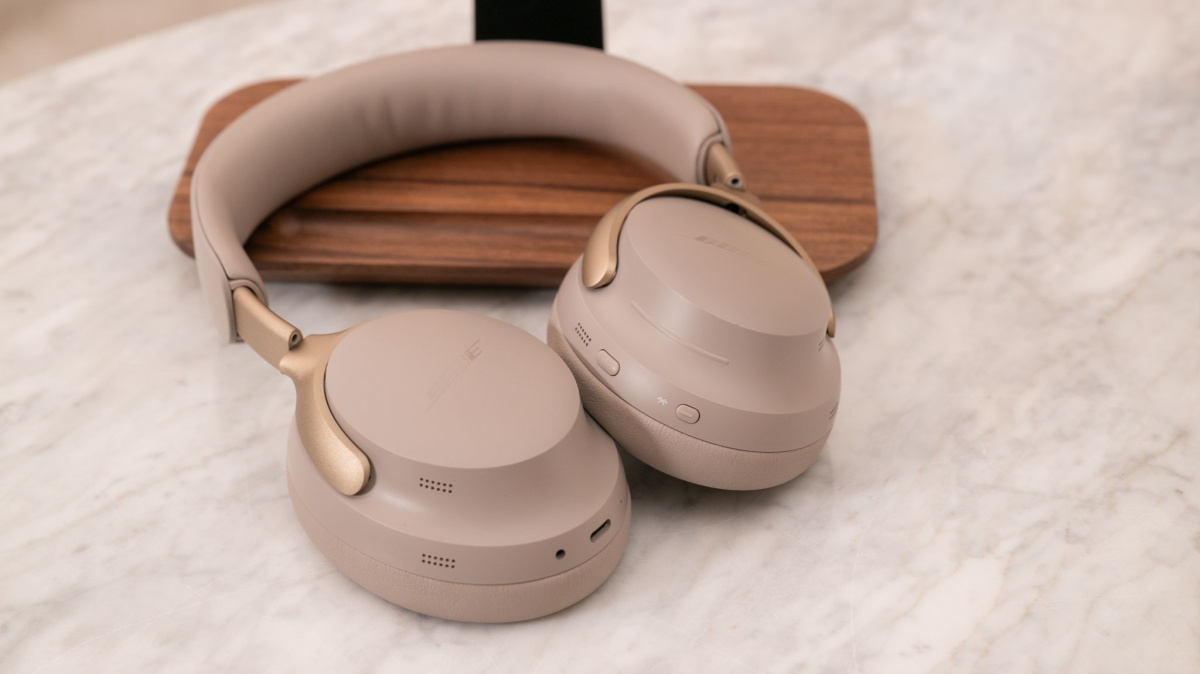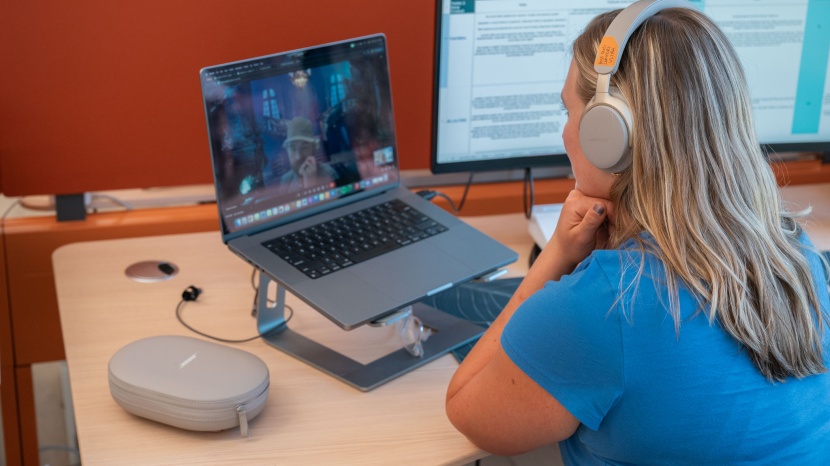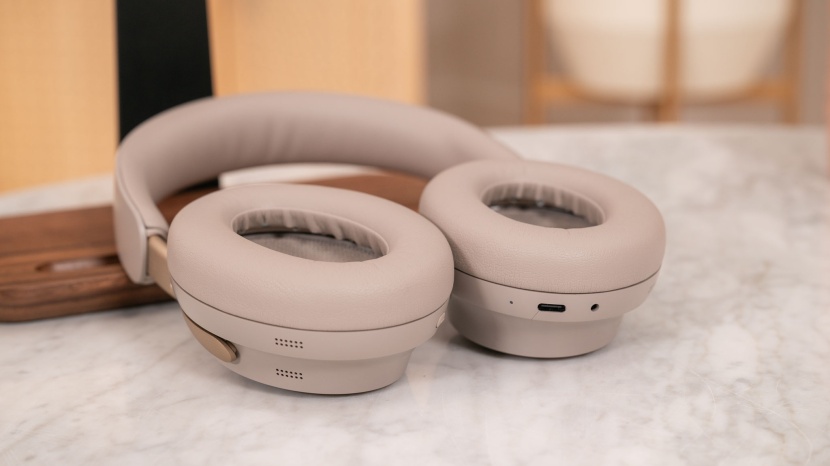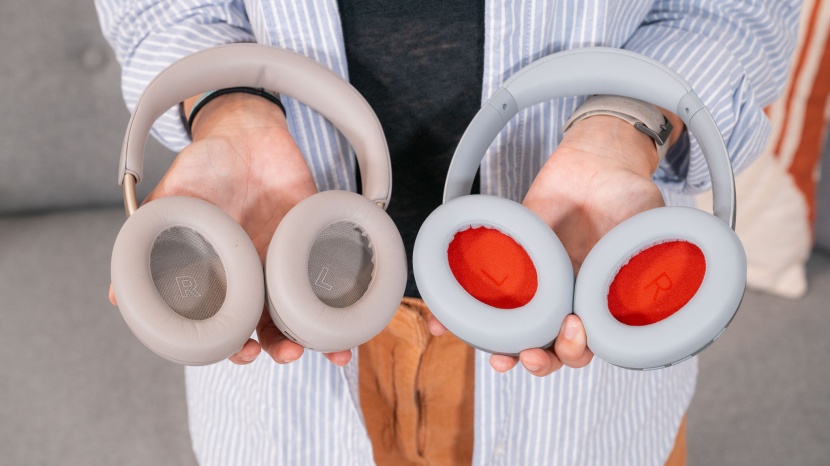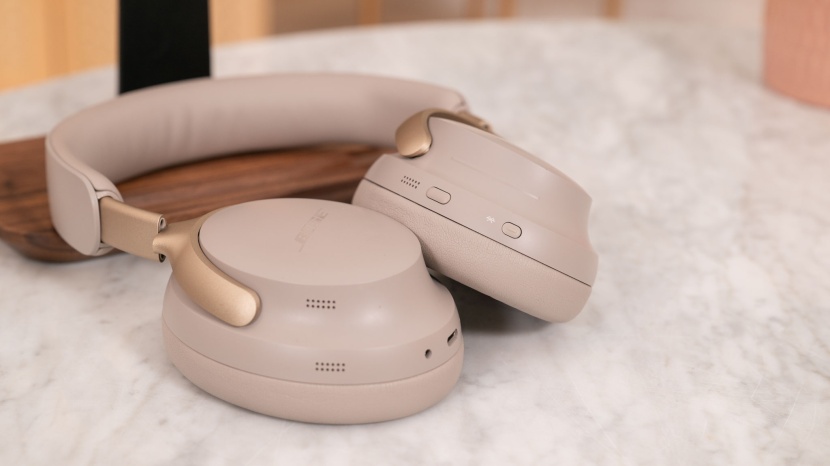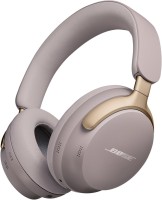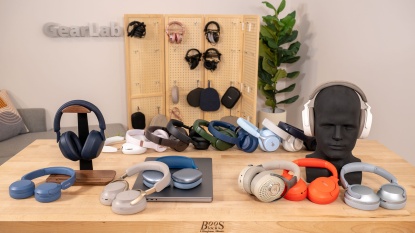Bose QuietComfort Ultra Headphones Review

Our Verdict
Our Analysis and Test Results
Our Bose QuietComfort Ultra Headphones Experience
The QuietComfort Ultra headphones are a high-end premium set that offer immersive sound, impressive noise cancellation, and a user experience that stands out in a crowd.
The Bose pairs well with various devices across different operating systems without any issues. The Ultra is one of the most user-friendly. The controls are intuitive and reliable, and the app offers a range of valuable features that are easy to navigate. We only wish the sound were a bit more customizable.
We enjoyed long listening sessions with the Ultra and were able to wear them for up to 10 hours at a time, longer than most competitors. They are lightweight, feel cushioned, and have a luxurious feel. They were some of the most comfortable we tried while wearing glasses.
The transparency mode is equally stunning, relaying ambient sounds so naturally that it felt like we weren't wearing headphones. While we love Bose's ANC and Aware modes, unlike most competitors, you can't turn either mode off completely; instead, it is a sliding scale of more ANC and less transparency, or vice versa.
While the Bose call quality is decent, it isn't the best, and we didn't like taking frequent calls or meetings using them. Sure, they get the job done, but it is subpar compared to the newer generation Ultras or some similarly priced competitors. If calls and meetings aren't a regular occurrence, it might not be a significant issue.
The luxe design of the QuietComfort Ultra is apparent as soon as you open the box. High-end craftsmanship in subdued colorways feels sophisticated. The TriPort venting system expands the acoustic space, making music sound bigger, bolder, and deeply immersive.
Sound Quality
The QuietComfort Ultra earned one of the highest sound scores for its all-encompassing, full-bodied, and well-balanced audio. The bass is clearly amped up, but never sounds bloated. The clarity is superb and remarkably consistent across the entire range of volumes. If you like punch and drama in your listening experience, the Ultra is it.
When you slip on these headphones, they calibrate the sound to your unique ear shape, ensuring that every listener receives the best audio quality. Music across all genres is relayed with an exciting and cinematic tone, energizing every track.
The bass is powerful yet tight and crisp across hip-hop, R&B, and pop artists like Doja Cat, The Weeknd, and the Notorious B.I.G. We even uncovered new details, like the low, computer-like thrum at 1:55 in Taylor Swift's “Glitch” which had previously gone unnoticed. While fun and punchy, it's important to note that some audiophiles may find the bass too strong for their taste.
The mids are beautifully developed, with a vivid range of color and pristine clarity. We loved listening to the nuanced details in folk, soft rock, and soul tracks, such as “Just a Letter” by James Keelaghan, “Tired of Being Alone” by Al Green, and “Helpless Hoping” by Crosby, Stills, & Nash. While the lows are turned up, the mids seem to hold their own and maintain a distinct presence in the mix.
The highs are lovely and clean, but feel a bit more distant. High-hitting vocals and instruments never sounded harsh, maintaining a rich character across pop, twangy Western, and opera. The harmonica solo in Mike Stevens' “Amazing Grace” is a prime example. Even when there's a crescendo on a high note at 3:42, these headphones maintained their dynamic balance, allowing us to bliss out without ever wincing. However, sometimes, vocals sounded veiled behind the lower frequencies, making them feel less developed than the other ranges. Still, they're incredibly pleasing.
We backed our expert opinions with a frequency response analysis to visualize exactly how the Ultra is tuned.
Like our Target Response Curve, the Ultra places more emphasis on the lows and highs, adding extra flair to accentuate the performance. The lows get the most boost, bringing on that head-bobbing energy that makes you want to groove.
Soundstage
We also consider the soundstage and how spacious the sound feels. The Ultras have one of the best soundstages, making the music feel like a rich cinematic listening experience.
Individual instruments and vocal lines are separated in space and relayed with outstanding clarity across a three-dimensional landscape. It's ever slightly more compressed than other top competitors, but it's still one of the most expansive soundscapes we have experienced.
Comfort and Fit
When it comes to comfort, the QuietComfort Ultra reigns supreme. The luxe materials are top-of-the-line, providing 10 solid hours of blissful wear time, even with glasses on.
The spacious earcups and adjustable headband feature plush cushions wrapped in a breathable, buttery-soft, faux leather material that feels luxurious and high-end. Combined with the headphone's gentle clamping force and lightweight design, the Bose Ultra is our favorite for long listening sessions.
Noise Cancellation
The noise canceling on the Ultras is some of the best, the Gen 2 does it better. The Ultras create an island of peaceful tranquility, no matter the surroundings.
The Ultra blocks out an astounding 20-40 decibels of noise across the entire frequency spectrum, with an average reduction of over 30 dB, reducing office chatter to blissful silence. People had to tap us to get our attention. Even roaring airplane engines and kitchen blenders were diminished to a whisper. While most headphones struggle to block out familiar everyday mid-range sounds, Bose excels in this regard.
In a bustling cafe, they do an incredible job of insulating the user from monotonous low-frequency hums and background chatter. A sudden, high-pitched dish clash at 0:16 is slightly louder but barely audible.
Despite all the ANC customization options in the Bose app, there is no option to turn off ANC without simultaneously turning on Aware mode. It's an odd choice for such an expensive headphone and may be a deal-breaker for those who are sensitive to full-powered ANC.
App and Controls
The most important features in an app are the sound equalizer (EQ) and presets. They should allow for fine-tuning of the sound, but in Bose's case, the adjustments feel limited. The three-point EQ slider wasn't very sensitive to changes, and there are only four presets. For those who like to tinker with the ranges, the limited customizations are disappointing.
When used in conjunction with a compatible audio file and device, Bose's Immersive Audio feature adds more dimensionality to the listening experience. It's basically the headphone equivalent of surround sound. The headphones track your head movements and adjust the imaginary field of speakers relative to your position. Some find this disorienting, but for others, it is a fun and exciting experience.
Android users with compatible devices that support Snapdragon Sound can unlock the Ultra's aptX Bluetooth codec for lossless audio, which promises better audio clarity.
Controls
The controls on the Ultras are one of our favorites because they are reliable and intuitive. A standard Bluetooth/Power button powers the headphones, connects to the device, or cycles between two connected devices. The Multifunction button controls media playback, phone call actions, and noise-canceling modes. A touch strip on the back of the earcup lets you adjust the volume. Often, touch controls can be finicky, but this one worked well.
In addition to hand-activated controls, the Ultra also supports hands-free head detection, which automatically pauses or plays the audio when it senses that you are wearing them, ensuring you never lose a second of your favorite song or podcast.
Battery
Battery life can be crucial if you travel frequently or prefer not to rely on frequent recharging. The Ultra has one of the shortest battery lives in our lineup, lasting about 24 hours. It's likely enough to get you through, but it falls short next to competitors that push 50-70 hours.
The Ultra supports fast charging, so 15 minutes of plug-in time will give you a couple of hours of play. For a full charge, you'll need to keep it plugged in for two to three hours. You can use the headphones while charging.
Call Quality
The QuietComfort Ultra call quality is slightly below average. The voice isolation technology does a decent job of removing distracting background sounds in noisy public spaces, but the baseline voice quality itself isn't the cleanest.
The Bose handled phone calls from the subway better than most, but fell short of the best. Loudspeaker announcements and whirring trains are clearly audible, but our callers' voices are at least pushed to the forefront without significant distortion.
Similarly, background voices, mouse clicks, and keyboard sounds are reduced in a noisy shared office space, but remain audible to the person on the other end. Plus, the caller's voice sounds slightly robotic, which could be distracting. When calling from a quiet space, the Ultra's grainy voice quality became more apparent. The caller's voice sounded dampened, making it hard to hear. Sometimes, words randomly cut out, which was frustrating. We'd rather use a cell phone than the Bose for phone calls.
| Awards | |
|---|---|
| Price | $429 List Check Amazon (on sale!) |
Overall Score  |
|
| Star Rating | |
| Bottom Line | Tune out the world and wrap yourself in a luxurious, surround-sound-like experience |
| Pros | Immersive sound, rich bass, first-class ANC, excellent comfort |
| Cons | Expensive |
| Rating Categories | Bose QuietComfort Ultra |
| Sound Quality (35%) | |
| Comfort (25%) | |
| Noise Cancellation (20%) | |
| App & Controls (10%) | |
| Call Quality (10%) | |
| Specifications | Bose QuietComfort Ultra |
| Comfortable Listening Hours | 10.0 hrs |
| Claimed Battery Life | 24 hrs |
| Wearing Detection | Yes |
| Multipoint | Yes |
| Measured Weight | 252 g |
| Measured Maximum Connectivity Distance | 171 ft |
| Measured Ear Cup Size | 59 mm H x 39 mm W |
| EQ Customization | Yes |
| Driver Size | 35 mm |
| Passive Playback | No |
| Spatial Audio | Yes |
| Active Noise Cancelling | Yes |
| Transparent Mode | Yes |
| Connectivity Options | AAC, AptX Adaptive, and SBC |
| Carrying Case | Case |
| Included Cords | -USB-A to USB-C cable -3.5 mm to 2.5 mm audio cable |


